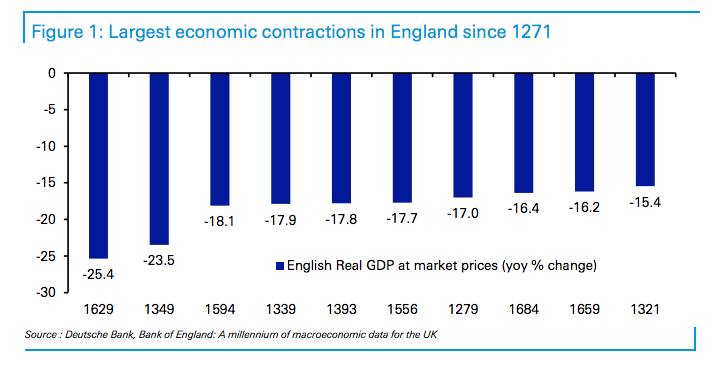But if the models hold true, 2020 is likely to be 'only' the third worst economic decline in human history, following the Influenza Pandemic years of 1919 and 1921. This analysis does not include the Great Depression because it was not caused by a pandemic. JL
Jamie Powell reports in FT Alphaville:
Pandemics have gone hand-in-hand with major economic contractions through history. “800 years of large economic contractions”, takes a look at historical GDP data of previous collapses in income to give some context for the second quarter (of 2020), which is the worst on record. The second largest annual contraction was in 1349, at the height of the Black Death. The current forecast of -6.5% for 2020 would make it the 3rd largest (annual) contraction, with only 1921 and 1919 seeing larger annual declines in economic output. The contraction after the financial crisis in 2008, was "only" -4.2%.
Deutsche Bank’s Jim Reid has been on a tear recently, not only getting out his excellent macro round-up every morning but also finding time, somehow, to put together a daily corona-specific report and some thematic research. Respect.Reid’s latest, titled “800 years of large economic contractions”, takes a look at the historical GDP data, where available, of previous collapses in national income to give some context for the upcoming second quarter print, which many reckon will be the worst on record.The oldest data available is from the Bank of England, and it dates back to 1271, which is about as far away as March 1 currently feels. So we’ll focus on that.Here’s how the contractions over that period look in chart form:
And here is DB’s explainer:Notably for today's circumstances, the second largest annual contraction was in 1349, at the height of the Black Death. The mortality rate as a result of the bubonic plague outbreak then was far in excess of today’s pandemic, with the Bank of England dataset showing that the English population fell from 4.81m in 1348 to just 2.60m in 1351, a reduction of over 40% in the space of 3 years. But it goes to show that pandemics have gone hand-in-hand with major economic contractions through history.If we focus our UK analysis after 1900, our current DB forecast of -6.5% for 2020 would make it the 3rd largest contraction over that time, with only 1921 and 1919 seeing larger annual declines in economic output. Even the annual contraction after the financial crisis in 2009, which was the largest since WWII, was "only" -4.2%.If you’re wondering what happened in those other years, here’s a flavour.In 1629, Charles I dissolved Parliament, marking the beginning of the Personal Rule -- a state of affairs where the king ruled over the country, without government, for 11 years. The country’s finances were in a particularly dire state at the time due to the disastrous Anglo-Spanish War (1625-30), with attempts to finance the war becoming increasingly contentious in parliament up to 1629. Of particular note is the infamous ‘Forced Loan’ of 1626, where Charles I unilaterally levied a tax on the population, and imprisoned anyone who refused to pay.See, there’s a good Zoom pub quiz question for those of you running them from your living room. Who says we don’t add value?




















0 comments:
Post a Comment